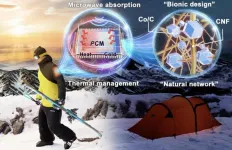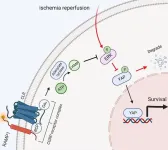A roadmap for digital neuroscience
A position paper by over 100 authors, now published in the journal Imaging Neuroscience, summarises the current status and identifies the key points for further developments in digital neuroscience
2024-04-23
(Press-News.org)
Neuroscience has entered a new, digital phase. The combination of brain research with supercomputing in large-scale, multi-disciplinary research collaborations has enabled an innovative approach to deciphering the brain, using powerful scientific technologies and data ressources. These developments open up new possibilities for brain research, medicine and technology. A position paper by over 100 authors, now published in the journal Imaging Neuroscience, summarises the current status and identifies the key points for further developments in digital neuroscience.
Digital technologies have fundamentally changed neuroscience in recent years. The challenges posed by increasingly large and complex data have been met with innovative shared platforms and novel tools for scientific investigation. Large-scale research initiatives within Europe and worldwide have shaped these developments and enabled synergies in scientific efforts. Examples include the EU Flagship Human Brain Project (HBP), and its digital research infrastructure EBRAINS, which enable scientists to integrate data from different scales according to FAIR principles, use models and software at EBRAINS for gaining new insights and working collaboratively on a larger scale. This change has led to significant progress and offers the opportunity to advance neuroscience, medicine and brain-inspired technologies.
Against this background, the position paper titled “The coming decade of digital brain research - A vision for neuroscience at the intersection of technology and computing” is primarily intended as a roadmap for digital neuroscience over the next ten years. "It is crucial that we assess, anticipate and shape the changes occuring in neuroscience and its related fields. The position paper identifies points of convergence and common goals, and provides a scientific framework for current and future developments in digital brain research based on a structured process of discussion with the research community at large," says lead author Prof. Katrin Amunts, Director at the Jülich Institute of Neuroscience and Medicine and Joint CEO of EBRAINS.
The position paper lists a total of eight key areas for digital neuroscience research. Near-term, middle-term and long-term goals are discussed, as well as novel developments like “digital twin”-approaches, with their applicability, potential and limitations in brain science. A “digital twin” is a type of personalised computational brain model that can be continuously updated with measured data obtained from its real-life counterpart, i.e., the patient. While not aimed at being an exact replica, the increasing sophistication and predictive power of these models is bringing new clinical and research applications into reach.
Further key areas described in the paper include ultra-high-resolution digital atlases and models of the brain that integrate multiple scales and modalities, neuro-derived artificial intelligence (AI) and computing innovations. EBRAINS has a key role in in the interaction between brain research and computing, offering scientists access to the most powerful European supercomputers via the computing network Fenix and to the brain-inspired computing systems BrainScaleS and SpiNNaker. An Executive Summary of the paper has been published on the website of the EBRAINS research infrastructure.
How the position paper came about
Two years ago, the HBP initiated an open and community-driven process integrating the views of researchers around the world. A first version by around 40 authors was published on the open publication platform Zenodo in March 2022 with a call to scientists, in particular outside the HBP, to contribute further perspectives. Input from new authors led to new versions published in regular intervals and promoted for further comment. The fifth and final version has now been published in the journal Imaging Neuroscience with the contribution of over 100 authors, not only from Europe, but also from the USA, Canada and Asia.
Original Publication:
K. Amunts et al., The coming decade of digital brain research. A vision for neuroscience at the intersection of technology and computing. Imaging Neuroscience (2024).
ABOUT EBRAINS
EBRAINS is a digital research infrastructure, created by the EU-funded Human Brain Project, to foster brain-related research and to help translate the latest scientific discoveries into innovation in medicine and industry, for the benefit of patients and society. It draws on cutting-edge neuroscience and offers an extensive range of brain data sets, a multilevel brain atlas, modelling and simulation tools, easy access to high-performance computing resources and to robotics and neuromorphic platforms.
All academic researchers have open access to EBRAINS’ state-of-the-art open science tools. Industry researchers are also very welcome to use the platform under specific agreements. For more information about EBRAINS, please contact us at info@ebrains.eu or visit www.ebrains.eu.
END
ELSE PRESS RELEASES FROM THIS DATE:
2024-04-23
OAK BROOK, Ill. – A diverse writing group—lead by authors at the University of Toronto—have developed an approach for radiology departments and practices to reduce their greenhouse gas emissions and become more resilient to the effects of climate change. They outlined their action plan in a Radiology in Focus article, published today in Radiology, a journal of the Radiological Society of North America (RSNA).
“Rising greenhouse gas emission levels lead to climate change, extreme weather events and worsening air pollution with downstream adverse health effects,” said lead author Kate Hanneman, M.D., M.P.H., vice chair of research ...
2024-04-23
SAN ANTONIO — April 23, 2024 — During this week’s ITS America Conference & Expo, Southwest Research Institute will share its latest intelligent transportation systems (ITS) research designed to integrate connected vehicle data exchanges and artificial intelligence into public transportation infrastructure.
“SwRI’s ITS solutions are designed to improve safety for the traveling public using software that helps transportation agencies operate more efficiently,” said Josh Johnson, ...
2024-04-23
New York, NY —The American Federation for Aging Research (AFAR) is pleased to announce the second cohort of the Hevolution/AFAR New Investigator Awards in Aging Biology and Geroscience Research, a grant program to enable early-career investigators with labs in the US and Canada to advance research projects in basic biology of aging, as well as geroscience projects that translate advances in basic research on aging biology from the laboratory to the clinic, paving the way for healthspan-expanding therapeutics and treatments. ...
2024-04-23
Living beings can evolve to lose biological structures due to potential survival benefits from such losses. For example, certain groups of ray-finned fishes show such regressive evolution—medakas, minnows, puffera, and wrasses do not have a stomach in the gastrointestinal tract, making them agastric or stomachless fishes. However, the specific evolutionary mechanisms underlying the evolution of agastric fishes remains unclear.
Studies about Slc26a9—a molecular transporter highly expressed in the stomach of many species—in fishes provided the initial clue. Researchers ...
2024-04-23
COLUMBUS, Ohio – Even subtle differences in the wording of social media messages may be enough to sway young people’s beliefs about depression and anxiety and their treatment.
In a new study, researchers found that college students were more optimistic about the possibility of successfully treating mental health problems after they read social media messages conveying what is called a “growth mindset.”
But social media posts written with a “fixed mindset” led young people to feel that depression and anxiety were more stable and innate, and not so easy to treat.
Growth mindset is the belief that a feature, such ...
2024-04-23
Electronic devices are getting more and more complex as they are built to carry out an ever-increasing number of functions. This can be seen in the increased functionality in our personal devices such as our phones, tablets and watches, let alone in industrial devices. However, their growing complexity can lead to performance and safety issues. These issues include device overheating or emitting microwaves that can result in health issues and that can reduce a device’s performance and interfere with other devices.
Chinese scientists from Beijing Normal University have been ...
2024-04-23
(Boston)—Mycobacterium tuberculosis, the bacteria that causes tuberculosis (TB), is distinct from most germs in its capacity to silently infect individuals for months and even years before waking up and causing active disease that can lead to severe illness and death. The immune system plays an important role in controlling the germ and keeping it dormant.
Decades of epidemiological data have linked undernutrition to TB. While undernourished individuals have blunted immune systems, a phenomenon which has been dubbed nutritionally acquired ...
2024-04-23
In the field of aerospace, a high-temperature piezoelectric vibration sensor is one of the few key devices that can be monitored in a high-temperature and harsh environment, so it is particularly urgent to develop high performance high-temperature piezoelectric ceramics as the core component of this kind of sensor. Bi4Ti3O12 (BIT), as one vital type of bismuth layered structure ferroelectrics (BLSFs), has great application prospects in high-temperature environments due to its excellent TC of 675 ℃. However, the volatilization of Bi during the sintering process in BIT-based ceramics leads to the generation of oxygen vacancy ...
2024-04-23
Background and Aims
Hepatic ischemia-reperfusion injury (HIRI) is a prevalent complication of liver transplantation, partial hepatectomy, and severe infection, necessitating the development of more effective clinical strategies. Receptor activity–modifying protein 1 (RAMP1), a member of the G protein–coupled receptor adapter family, has been implicated in numerous physiological and pathological processes. The study aimed to investigate the pathogenesis of RAMP1 in HIRI.
Methods
We established a 70% liver ischemia-reperfusion model in RAMP1 knockout (KO) and wild-type mice. Liver and ...
2024-04-23
Thermophilic fungi are chief components of mycoflora in a variety of natural and manmade composting systems, including rotting hay, stored grains, wood mulch, nesting material of birds and animals, municipal refuse, and self-heating accumulated organic matter. Thermophilic fungi are also a potential source of natural products, which complement the metabolite libraries of mesophilic fungi and bacteria.
The research team led by Prof. Dr. Xuemei Niu (State Key Laboratory for Conservation and Utilization of Bio-Resources in Yunnan, Yunnan University) has been working on the discovery of secondary metabolites in thermophilic fungi and their biological ...
LAST 30 PRESS RELEASES:
[Press-News.org] A roadmap for digital neuroscience
A position paper by over 100 authors, now published in the journal Imaging Neuroscience, summarises the current status and identifies the key points for further developments in digital neuroscience






